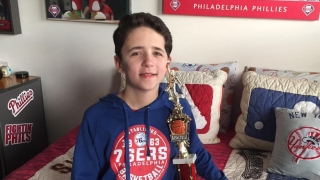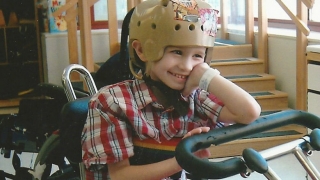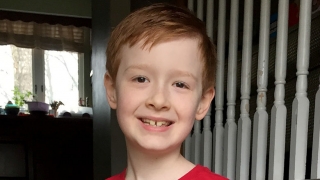When an ultrasound revealed Christine (Chris) was carrying another boy, her 3 ½-year-old son Matt started planning. He was going to teach his baby brother everything about baseball — how to pitch, how to catch, how to swing a bat. Matt couldn’t wait to get started.
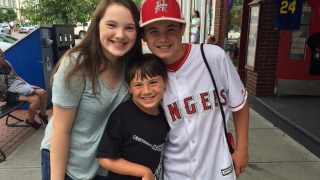 Aubrey, Nate and Matt
But two days after Nate’s birth, a series of tests revealed that he had suffered a devastating hemorrhagic stroke while still developing in the womb. The stroke destroyed 95 percent of the left half of his brain and two-thirds of the right.
Aubrey, Nate and Matt
But two days after Nate’s birth, a series of tests revealed that he had suffered a devastating hemorrhagic stroke while still developing in the womb. The stroke destroyed 95 percent of the left half of his brain and two-thirds of the right.
Chris and her husband, Jason, were in shock. They couldn’t imagine what the future would hold for their newborn son. They certainly didn’t think it would include baseball.
But now, nine years later, Nate pitches, plays outfield, and bats for his Little League team. And before older brother Matt got too busy with his own baseball team, he spent every game watching Nate from the dugout.
“Nate can walk. He can run. He’s awesome,” Chris says. “He is doing better than I could have ever imagined nine years ago.”
The diagnosis
Nate’s birth in February 2007 was fairly typical. His heart rate, respiratory function, muscle tone and other medical measurements were good and his cry seemed healthy.
But to his mom, something looked a little “off.” Nate’s head was slightly cone shaped and seemed larger than normal. When doctors at their local hospital suggested Nate have an ultrasound, Chris and Jason readily agreed.
Soon the couple learned Nate had fluid on this brain and needed specialized care. He was transferred to Children’s Hospital of Philadelphia (CHOP). Once there, Nate underwent extensive testing which revealed a ruptured blood vessel in his head — he’d had a stroke.
Nate spent seven days in the Newborn/Infant Intensive Care Unit at CHOP under the care of Rebecca N. Ichord, MD, Director of CHOP’s Pediatric Stroke Program. The stroke had left behind dried blood that blocked the usual drainage channels in Nate’s brain, causing hydrocephalus, a buildup of fluid in the brain.
In a month he would need a shunt inserted in one of his brain ventricles to continuously drain the cerebral spinal fluid, but despite the extensive loss of brain tissue, Nate was not in critical condition. There was no reason he couldn’t go home with his family in the meantime.
Nate’s older siblings, Matt and 5-year-old Aubrey, were excited to have their brother home.
“The kids were at an age where they didn’t look at him as any different,” Chris says. “He was just their baby brother.”
Sibling help
Because he was diagnosed so quickly, Nate and his family had access to early intervention services right away. Six weeks after Nate’s shunt surgery, specialists began home visits to work with him. Some days, as many as three different specialists came to the house.
Physical and occupational therapists worked with the entire family to teach them how to help Nate compensate for his brain injury. Because Nate lacked awareness of his right side, the family’s main task was to remind him to use his right hand. Aubrey and Matt would lift Nate’s tiny arm and help him bat at the toys dangling from the baby gym above his head.
“If he would go to hit something with his left hand, Matt would grab his right hand and say, ‘Don’t forget this one!’” Chris says. “Even the kids’ friends would tell Nate, ‘Use two hands!’”
Aubrey displayed a patience with her little brother that was beyond her years, while Matt never wavered from his original goal: to play baseball with his brother.
And it worked. The first time Nate intentionally opened his right hand, it was to catch a ball.
Learning to adapt
In his first four years of life, Nate had 12 surgeries. At times the shunt in his brain would become blocked and Nate would have to be rushed back to CHOP for emergency surgery.
During that period, Chris relied heavily on the Pediatric Stroke Parent Support Group at CHOP. The connections she made there were invaluable. “Being able to hear how other families deal with these things, it was a lifeline,” Chris says.
Nate’s older siblings also learned how to cope with the uncertainty and disruptions that come with having a family member with a serious medical condition. For example, Nate’s brain injury makes it difficult for him to tolerate frustration, and he would often unleash his temper on his brother Matt. And there were days when Matt and Aubrey would come home from school and learn they’d be staying with their grandmother because Nate was back in the hospital.
From the beginning, Chris says, she and her husband have been very open with their children about Nate’s condition and how it affects each member of their family. As a result, Nate’s siblings feel comfortable with him — and other children who are sick or disabled.
Recently, a teacher overheard Aubrey speaking with a fellow student who has Down syndrome. Aubrey’s kindness toward the boy nearly brought the teacher to tears, Chris said. And two years ago when Matt was assigned to write an essay about his hero, he chose Nate.
A dream realized
Nate’s condition has been stable since he was 4 years old, when surgeons transferred the shunt from the left ventricle to the right.
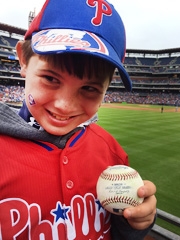 Today, Nate is an active and sociable fourth grader. He attends regular classes, but receives extra help in language arts and math. His right side is still significantly weaker than his left, so he wears a leg brace and uses his left hand almost exclusively.
Today, Nate is an active and sociable fourth grader. He attends regular classes, but receives extra help in language arts and math. His right side is still significantly weaker than his left, so he wears a leg brace and uses his left hand almost exclusively.
Despite his physical limitations, Nate finds ways to keep up with the other kids on the playground and play baseball, the sport his brother taught him to love. Since he pitches and catches with the same hand, Nate figured out a quick way to make the switch from hand to glove.
And when it’s his turn in the batter’s box and he connects with the ball, he runs as fast as he can down the baseline — propelled by the cheers of his family and friends.
“Nate’s not the best player on the team, but he’s not the worst, either,” Chris says. “And that’s more than anyone could have hoped for.”
Originally published October 2016
